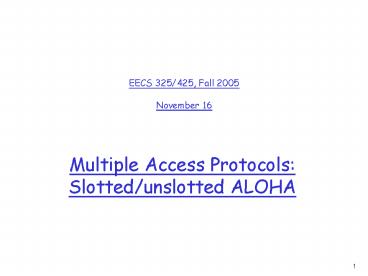Multiple Access Protocols: Slottedunslotted ALOHA - PowerPoint PPT Presentation
1 / 14
Title:
Multiple Access Protocols: Slottedunslotted ALOHA
Description:
CSMA/CD collision detection. 11. Summary of MAC protocols. Channel Partitioning ... How to calculate the efficiency of Aloha, Slotted Aloha, and CSMA/CD? 13 ... – PowerPoint PPT presentation
Number of Views:215
Avg rating:3.0/5.0
Title: Multiple Access Protocols: Slottedunslotted ALOHA
1
Multiple Access Protocols Slotted/unslotted
ALOHA
EECS 325/425, Fall 2005 November 16
2
Link Layer
- 5.1 Introduction and services
- 5.2 Error detection and correction
- 5.3Multiple access protocols
- 5.4 Link-Layer Addressing
- 5.5 Ethernet
- 5.6 Hubs and switches
- 5.7 PPP
- 5.8 Link Virtualization ATM
3
Random Access Protocols
- When node has packet to send
- transmit at full channel data rate R.
- no a priori coordination among nodes
- two or more transmitting nodes -gt collision,
- random access MAC protocol specifies
- how to detect collisions
- how to recover from collisions (e.g., via delayed
retransmissions) - Examples of random access MAC protocols
- slotted ALOHA
- unslotted ALOHA
- CSMA, CSMA/CD, CSMA/CA
4
Slotted ALOHA
- Assumptions
- all frames have same size
- time is divided into equal size slots a slot
time to transmit 1 frame - nodes start to transmit frames only at beginning
of slots (aligned) - nodes are synchronized
- if 2 or more nodes transmit in slot, all nodes
detect collision
- Operation
- when node obtains fresh frame, it transmits in
next slot - no collision, node can send new frame in next
slot - if collision, node retransmits frame in each
subsequent slot with probability p until success
5
Slotted ALOHA
- Pros
- single active node can continuously transmit at
full rate of channel - highly decentralized only slots in nodes need to
be in sync - simple
- Cons
- collisions, wasting slots
- idle slots
- nodes may be able to detect collision in less
than time to transmit packet
6
Pure (unslotted) ALOHA
- unslotted Aloha simpler, no synchronization
- when frame first arrives
- transmit immediately
- collision probability increases
- frame sent at t0 collides with other frames sent
in t0-1,t01
7
CSMA (Carrier Sense Multiple Access)
- CSMA listen before transmit (basic idea)
- If channel sensed idle transmit entire frame
- If channel sensed busy, defer transmission
8
CSMA collisions
spatial layout of nodes
collisions can still occur propagation delay
means two nodes may not hear each others
transmission
collision entire packet transmission time wasted
note role of distance propagation delay in
determining collision probability
9
CSMA/CD (Collision Detection)
- CSMA/CD carrier sensing, deferral as in CSMA
- collisions detected within short time
- colliding transmissions aborted, reducing channel
wastage - collision detection
- easy in wired LANs measure signal strengths,
compare transmitted, received signals - difficult in wireless LANs receiver shut off
while transmitting
10
CSMA/CD collision detection
11
Summary of MAC protocols
Random access
Channel Partitioning
Taking Turns
- Time Division
- Frequency Division
- Code Division
- ALOHA
- S-ALOHA
- CSMA
- CSMA/CD
- Polling
- Token passing
12
Ideal Multiple Access Protocol
- Random access, channel of rate R bps
- 1. When one node wants to transmit, it can send
at rate R. - 2. When N nodes want to transmit, each can send
at average rate R/N - 3. Fully decentralized
- no special node to coordinate transmissions
- no synchronization of clocks, slots
- 4. Simple
?
Efficiency is the long-run fraction of successful
slots when theres many nodes, each with many
frames to send. How to calculate the efficiency
of Aloha, Slotted Aloha, and CSMA/CD?
13
Slotted Aloha efficiency
- For max efficiency with N nodes, find p that
maximizes Np(1-p)N-1 - For many nodes, take limit of Np(1-p)N-1 as N
goes to infinity, gives 1/e .37
Efficiency is the long-run fraction of
successful slots when there are many nodes, each
with many frames to send
- Suppose N nodes with many frames to send, each
transmits in slot with probability p - prob that node 1 has success in a slot
p(1-p)N-1 - prob that any node has a success Np(1-p)N-1
At best channel used for useful transmissions
37 of time!
14
Pure Aloha efficiency
- P(success by given node) P(node transmits) .
- P(no
other node transmits in p0-1,p0 . - P(no
other node transmits in p0-1,p0 - p .
(1-p)N-1 . (1-p)N-1 - p .
(1-p)2(N-1) - choosing optimum
p and then letting n -gt infty ... -
1/(2e) .18
Even worse !































